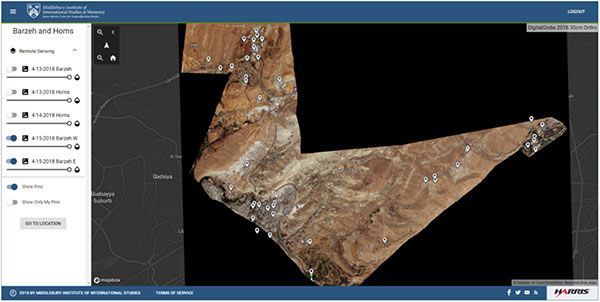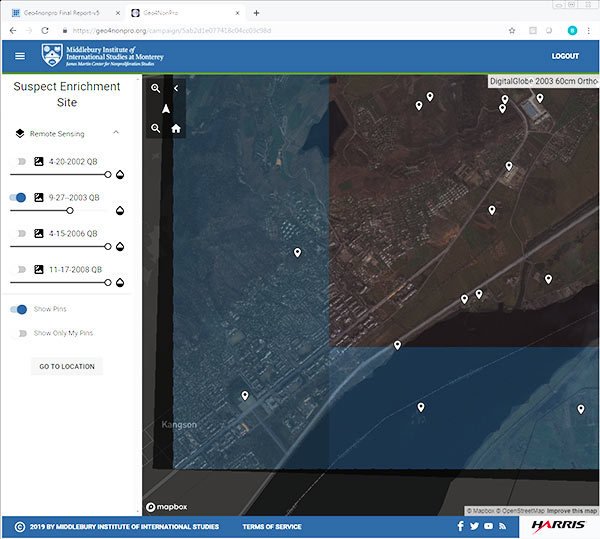Remote Sensing Sleuths Suss Out WMDs
Have you ever fantasized about discovering an unknown cache of weapons of mass destruction (WMDs), saving the world, and being heralded as a hero? Now’s your chance, and you don’t even have to unplug and leave home thanks to advancements in geospatial intelligence software for defense and intelligence!

This is an image of a site at Homs, which US, UK, and French militaries identified as a suspected facility related to Syria’s chemical-weapons program.
Geo4Nonpro.org is a website that unites geospatial hobbyists, experts, and novices to use satellite imagery to discover insights into WMD programs around the world. The site was championed by Melissa Hanham, Senior Research Associate Center at the James Martin Center for Non-proliferation Studies (CNS). “The site brings together experts in a wide variety of fields to provide insights into the images that we in this field spend our days combing through,” said Hanham.
Hanham’s interest in remote sensing and fusing data sets led her to propose the project a few years ago. “We received funding to purchase commercial satellite imagery and from there we chose which sites we thought would be relevant to WMD development or proliferation, and also which sites would be best understood with remote sensing data,” explained Hanham. The first iteration of the site was a good proof of concept, but technically was not easy to use. “With crowd sourcing we wanted to make it as easy to use as possible, so we searched for a professional engineering team that could produce a more user-friendly website. NV5 Geospatial has made our site super usable,” said Hanham. “All you have to do is register on the site and then you can see images and provide comments.”
“The interface CNS was using lacked modern tools for data access, location marking, and data viewing, which slowed down work on the site, and discouraged prolonged use,” according to Barrett Sather who was the NV5 Geospatial project manager. “We worked with the team at CNS to provide a modern web front end for analyzing these locations of high interest. The new interface was designed to be more user friendly to ensure that users spend more time on the site making more discoveries,” said Sather.
“Our mission at CNS is to provide research and analysis of proliferation efforts around the world and to train the next generation on how to prevent the spread of WMDs,” said Hanham. “We study nuclear, chemical, biological weapons -- the way in which they spread to new countries, the way in which money is laundered, equipment is illicitly procured, or WMDs are strategically employed,” said Hanham. “And then we also look at their delivery devices. Primarily missiles, but also bombers.”
The biggest find on Geo4Nonpro.org, and according to Hanham perhaps the biggest find in the history of open source research, was the uranium enrichment facility in Kangson, North Korea. “This was a previously unknown enrichment facility that is making the fissile material for North Korean nuclear weapons,” Hanham says for emphasis.
“We had tidbits of information from other intelligence sources pointing to the existence of an undeclared, covert uranium enrichment facility somewhere in North Korea,” according to CNS Research Associate Grace Liu. “We had somewhat of a constraint of geographical area to look at, so we started perusing high-frequency and high-res satellite imagery to look for certain markers of a secret facility,” says Liu.
Some of the markers the team knew to identify included a smaller area with a secured parameter, for example with fencing. These facilities tend to have only one or two entrances for vehicle, and at those entrances there are likely check points. Another thing they knew to look for was nicer apartment buildings for skilled workers. “Then we know culturally in North Korea any of the significant sites that the “Kims” have visited tend to have monuments memorializing their visiting this area,” says Liu. “With all that information we narrowed down the location to two potential candidates, and then finally to the Kangson facility.
Indeed, the Kangson site has a wall surrounding a large facility, another wall surrounding an area with nice apartment buildings, one road in, a checkpoint, a helicopter pad, a mural and a pillar. The mural and pillar indicate a visit from late North Korean leader Kim Jung Il.

This is an image of the uranium enrichment site at Kangson, North Korea.
The team discovered that the site in question did not exist in 2001. Building started in 2002 and by the end of 2003 the facility appeared to be operational, a fact in part gleaned by the fact that the enrichment facility roof is the only building in the area without snow on its roof in winter, indicating a strong heat source inside. Nonproliferation experts have long suspected that North Korea had other uranium enrichment plants than the declared one in Yongbyon, which was established in 2010. The discovery by CNS means that North Koreans were enriching uranium many years prior to that.